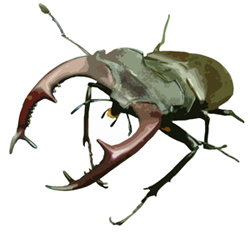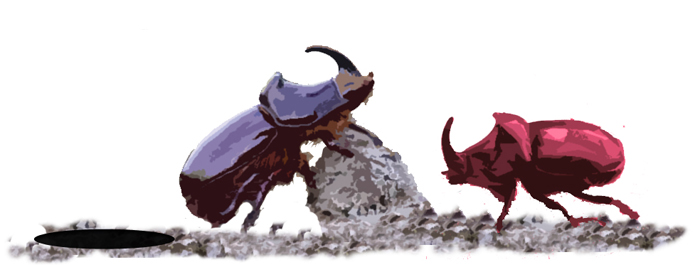 Las claves de la evolución de las especies son la variación que hay entre los organismos de una misma especie, la selección que la naturaleza hace de los individuos y el tiempo, mucho tiempo.
Las claves de la evolución de las especies son la variación que hay entre los organismos de una misma especie, la selección que la naturaleza hace de los individuos y el tiempo, mucho tiempo.
Para estudiar cómo las especies cambian con el tiempo, un grupo de biólogos está estudiando una población de escarabajos de la especie Ovalis glucosi. Aunque desde que se conoce a estos escarabajos su color es azul, hace ya unos años se ha observado que cada vez hay más individuos de color rojo. Los científicos piensan que si son capaces de comprender el motivo por el que está ocurriendo este cambio, van a aprender un montón sobre cómo evolucionan las especies.
A los escarabajos O. glucosi les encanta guardar su comida en un agujero que excavan en el suelo. Durante varios días van recogiendo todo el alimento que se encuentran y lo guardan en su guarida. De este modo, pueden pasarse varios días sin tener que buscar nada. Bajan a comer cuando tienen hambre y descansan al sol tapando el agujero de su despensa. Como podemos imaginar, tapar la entrada del túnel es importantísimo si quieren impedir que venga otro escarabajo y les quite su comida...
Pero claro, cuando un escarabajo ve a otro quieto tomando el sol, se acerca para ver qué está escondiendo. El que está protegiendo su comida entra en su túnel y tapa con su cuerpo el agujero. Empieza entonces una pelea terrible por ver quien se hace dueño de todo lo que hay en el fondo del agujero.
Los dos escarabajos se empiezan a empujar con todas sus fuerzas hasta que uno de ellos aplasta al otro y gana la batalla. Una batalla cuyo premio es la comida que hay guardada en el fondo del túnel.
A los biólogos les ha parecido que los escarabajos rojos son un poco más fuertes que los azules. Y piensan que como ganan más veces en sus peleas consiguen más comida. Esa podría ser la explicación de que cada vez haya más escarabajos rojos y cada vez menos azules.
Pero para demostrarlo tienen que hacer un experimento. Y nosotros podemos echarles una mano.
Divididos en equipos, el profesor tiene que repartir en dos bolsas de plástico diez escarabajos rojos y diez azules (en realidad son chocolates tipo Lacasitos o M&Ms).
 Para averiguar cuales son más fuertes, si los rojos o los azules, los alumnos tienen que colocarlos en parejas y apretar con los dedos hasta que noten que uno de ellos se ha roto.
Para averiguar cuales son más fuertes, si los rojos o los azules, los alumnos tienen que colocarlos en parejas y apretar con los dedos hasta que noten que uno de ellos se ha roto.
Para cada una de las parejas de escarabajos hay que anotar cuál se rompió primero, si el rojo o el azul. En el caso de que los dos estén rotos se apuntará el que esté más roto de los dos.
Una vez que hayan terminado todos los grupos, hay en poner en común los resultados obtenidos y sumar los números de todos y cada una de las parejas.
- ¿Por qué creéis que es importante considerar los resultados de toda la clase y no sólo los de un grupo?
- ¿Hay alguna relación entre el color y la fuerza de los escarabajos? De acuerdo con los datos obtenidos, ¿podemos decir que alguno de los dos tipos de escarabajos consigue más comida?
- ¿Encuentras explicación al hecho de que haya cada vez más escarabajos rojos?
- ¿Podrán llegar a desaparecer algún día los escarabajos azules?
Esta práctica nos la enseñó Mary Colvard, profesora del Cobleskill-Richmondville High School de Cobleskill, Nueva York (Estados Unidos) y está basada en la observación de que los M&Ms de color rojo son un poco más duros que los de color azul. Si te interesa, esta práctica dirigida a alumnos de 3º y 4º de Primaria se puede descargar en pdf (1,17 MB).






